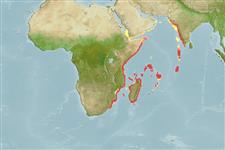Environment: milieu / climate zone / depth range / distribution range
Ekologi
marina bottenlevande; djupintervall 20 - 406 m (Ref. 51668). Tropical; 23°N - 30°S, 30°E - 80°E
Western Indian Ocean: Natal, South Africa to India.
Size / Vikt / Age
Maturity: Lm ? range ? - ? cm
Max length : 19.0 cm TL hane/ej könsbestämd; (Ref. 6270)
Short description
Bestämningsnycklar | Morfologi | Morfometri
Taggstrålar i ryggfenan (totalt) : 0; Mjukstrålar i ryggfenan (totalt) : 55 - 60; Taggstrålar i analfenan: 0; Mjukstrålar i analfenan: 46 - 49. Eyed side dark brown, with black spots and blotches forming vague crossbars; dark bar on at caudal fin base; blind side dark brown; round black spots on head (Ref. 6270).
Life cycle and mating behavior
Maturities | Reproduktion | Spawnings | Egg(s) | Fecundities | Larver
Heemstra, P.C., 1986. Pleuronectidae. p. 863-865. In M.M. Smith and P.C. Heemstra (eds.) Smith's sea fishes. Springer-Verlag, Berlin. (Ref. 6270)
IUCN Red List Status (Ref. 130435)
Threat to humans
Harmless
Human uses
Verktyg
Special reports
Download XML
Internet-källor
Estimates based on models
Preferred temperature (Ref.
123201): 15.8 - 25.3, mean 21.4 °C (based on 65 cells).
Phylogenetic diversity index (Ref.
82804): PD
50 = 0.7500 [Uniqueness, from 0.5 = low to 2.0 = high].
Bayesian length-weight: a=0.01995 (0.00906 - 0.04395), b=3.01 (2.83 - 3.19), in cm total length, based on all LWR estimates for this body shape (Ref.
93245).
Trofisk nivå (Ref.
69278): 3.6 ±0.4 se; based on size and trophs of closest relatives
Fishing Vulnerability (Ref.
59153): Low vulnerability (10 of 100).
